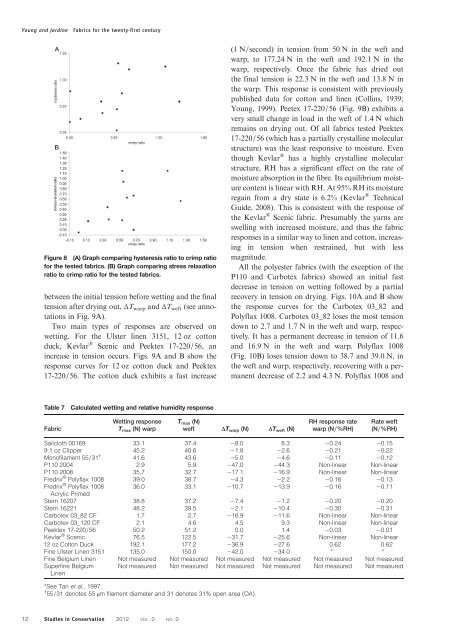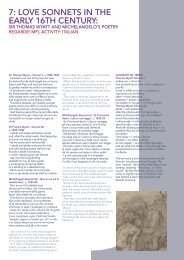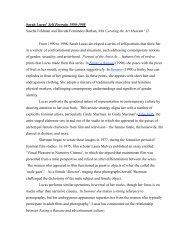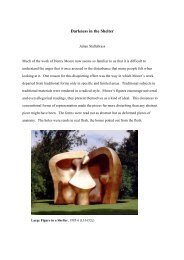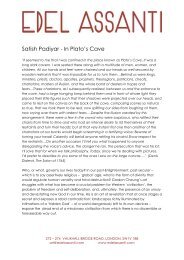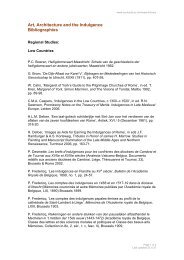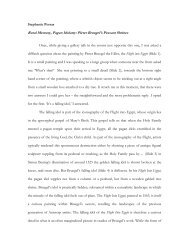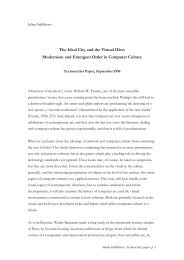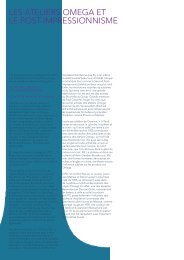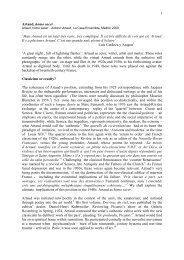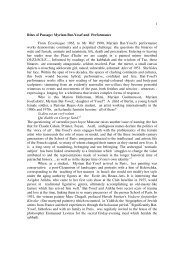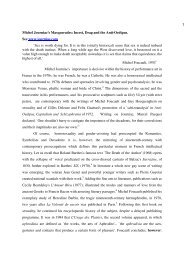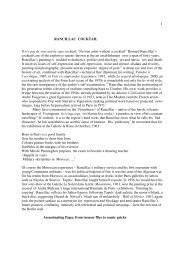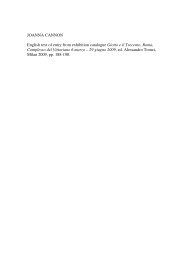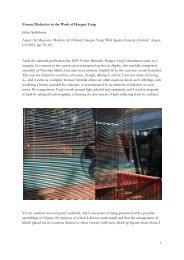Fabrics for the twenty-first century - The Courtauld Institute of Art
Fabrics for the twenty-first century - The Courtauld Institute of Art
Fabrics for the twenty-first century - The Courtauld Institute of Art
Create successful ePaper yourself
Turn your PDF publications into a flip-book with our unique Google optimized e-Paper software.
Young and Jardine <strong>Fabrics</strong> <strong>for</strong> <strong>the</strong> <strong>twenty</strong>-<strong>first</strong> <strong>century</strong><br />
12<br />
Figure 8 (A) Graph comparing hysteresis ratio to crimp ratio<br />
<strong>for</strong> <strong>the</strong> tested fabrics. (B) Graph comparing stress relaxation<br />
ratio to crimp ratio <strong>for</strong> <strong>the</strong> tested fabrics.<br />
between <strong>the</strong> initial tension be<strong>for</strong>e wetting and <strong>the</strong> final<br />
tension after drying out, ΔTwarp and ΔTweft (see annotations<br />
in Fig. 9A).<br />
Two main types <strong>of</strong> responses are observed on<br />
wetting. For <strong>the</strong> Ulster linen 3151, 12 oz cotton<br />
duck, Kevlar ® Scenic and Peektex 17-220/56, an<br />
increase in tension occurs. Figs. 9A and B show <strong>the</strong><br />
response curves <strong>for</strong> 12 oz cotton duck and Peektex<br />
17-220/56. <strong>The</strong> cotton duck exhibits a fast increase<br />
Table 7 Calculated wetting and relative humidity response<br />
Fabric<br />
Wetting response<br />
Tmax (N) warp<br />
(1 N/second) in tension from 50 N in <strong>the</strong> weft and<br />
warp, to 177.24 N in <strong>the</strong> weft and 192.1 N in <strong>the</strong><br />
warp, respectively. Once <strong>the</strong> fabric has dried out<br />
<strong>the</strong> final tension is 22.3 N in <strong>the</strong> weft and 13.8 N in<br />
<strong>the</strong> warp. This response is consistent with previously<br />
published data <strong>for</strong> cotton and linen (Collins, 1939;<br />
Young, 1999). Peetex 17-220/56 (Fig. 9B) exhibits a<br />
very small change in load in <strong>the</strong> weft <strong>of</strong> 1.4 N which<br />
remains on drying out. Of all fabrics tested Peektex<br />
17-220/56 (which has a partially crystalline molecular<br />
structure) was <strong>the</strong> least responsive to moisture. Even<br />
though Kevlar ® has a highly crystalline molecular<br />
structure, RH has a significant effect on <strong>the</strong> rate <strong>of</strong><br />
moisture absorption in <strong>the</strong> fibre. Its equilibrium moisture<br />
content is linear with RH. At 95% RH its moisture<br />
regain from a dry state is 6.2% (Kevlar ® Technical<br />
Guide, 2008). This is consistent with <strong>the</strong> response <strong>of</strong><br />
<strong>the</strong> Kevlar ® Scenic fabric. Presumably <strong>the</strong> yarns are<br />
swelling with increased moisture, and thus <strong>the</strong> fabric<br />
responses in a similar way to linen and cotton, increasing<br />
in tension when restrained, but with less<br />
magnitude.<br />
All <strong>the</strong> polyester fabrics (with <strong>the</strong> exception <strong>of</strong> <strong>the</strong><br />
P110 and Carbotex fabrics) showed an initial fast<br />
decrease in tension on wetting followed by a partial<br />
recovery in tension on drying. Figs. 10A and B show<br />
<strong>the</strong> response curves <strong>for</strong> <strong>the</strong> Carbotex 03_82 and<br />
Polyflax 1008. Carbotex 03_82 loses <strong>the</strong> most tension<br />
down to 2.7 and 1.7 N in <strong>the</strong> weft and warp, respectively.<br />
It has a permanent decrease in tension <strong>of</strong> 11.6<br />
and 16.9 N in <strong>the</strong> weft and warp. Polyflax 1008<br />
(Fig. 10B) loses tension down to 38.7 and 39.0 N, in<br />
<strong>the</strong> weft and warp, respectively, recovering with a permanent<br />
decrease <strong>of</strong> 2.2 and 4.3 N. Polyflax 1008 and<br />
T max (N)<br />
weft ΔTwarp (N) ΔTweft (N)<br />
RH response rate<br />
warp (N/%RH)<br />
Rate weft<br />
(N/%RH)<br />
Sailcloth 00169 33.1 37.4 −8.0 8.3 −0.24 −0.15<br />
9.1 oz Clipper 45.2 40.6 −1.8 −2.6 −0.21 −0.22<br />
Mon<strong>of</strong>ilament 55/31 †<br />
41.6 43.6 −5.0 −4.6 −0.11 −0.12<br />
P110 2004 2.9 5.9 −47.0 −44.3 Non-linear Non-linear<br />
P110 2008 35.7 32.7 −17.1 −16.9 Non-linear Non-linear<br />
Fredrix ® Polyflax 1008 39.0 38.7 −4.3 −2.2 −0.16 −0.13<br />
Fredrix ® Polyflax 1008<br />
Acrylic Primed<br />
36.0 33.1 −10.7 −13.9 −0.16 −0.11<br />
Stern 16207 38.8 37.2 −7.4 −1.2 −0.20 −0.20<br />
Stern 16221 48.2 39.5 −2.1 −10.4 −0.30 −0.31<br />
Carbotex 03_82 CF 1.7 2.7 −16.9 −11.6 Non-linear Non-linear<br />
Carbotex 03_120 CF 2.1 4.6 4.5 9.3 Non-linear Non-linear<br />
Peektex 17-220/56 50.2 51.2 0.0 1.4 −0.03 −0.01<br />
Kevlar ® Scenic 76.5 122.5 −31.7 −25.6 Non-linear Non-linear<br />
12 oz Cotton Duck 192.1 177.2 −36.9 −27.6 0.62 0.62<br />
Fine Ulster Linen 3151 135.0 150.0 −42.0 −34.0 * *<br />
Fine Belgium Linen Not measured Not measured Not measured Not measured Not measured Not measured<br />
Superfine Belgium<br />
Linen<br />
Not measured Not measured Not measured Not measured Not measured Not measured<br />
*See Tan et al., 1997.<br />
† 55/31 denotes 55 μm filament diameter and 31 denotes 31% open area (OA).<br />
Studies in Conservation 2012 VOL. 0 NO. 0


